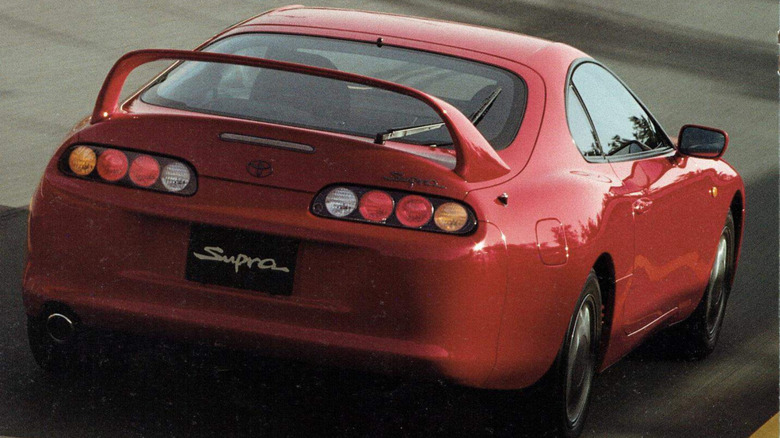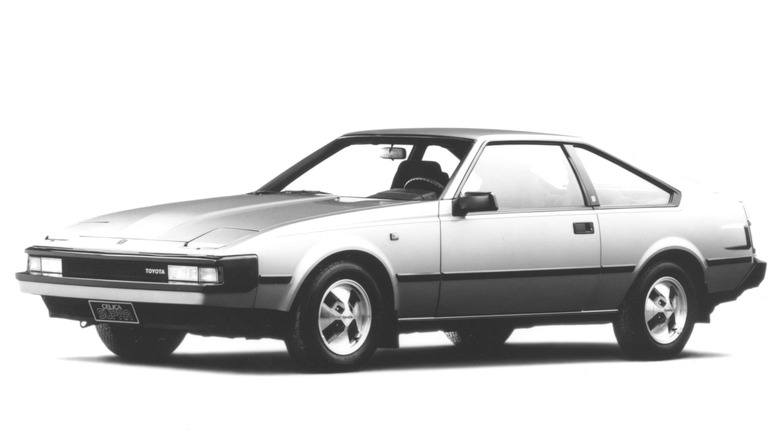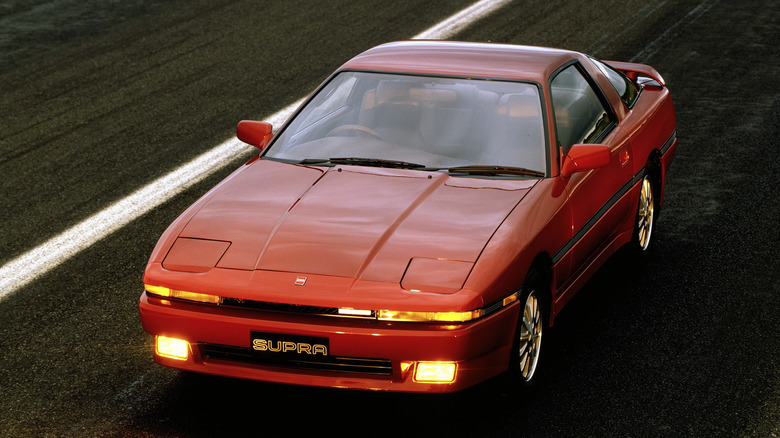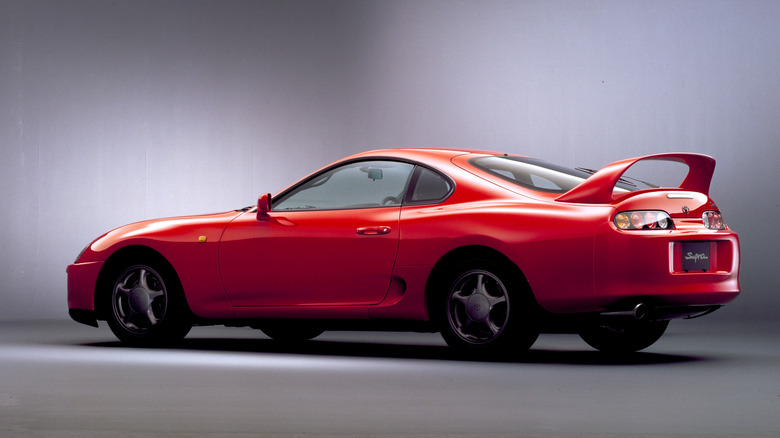Every Toyota Supra Generation Ranked By Horsepower
Few names resonate within today's JDM community like the Toyota Supra. And it's no surprise, with the car boasting a heritage of sportiness and aesthetic excellence since the late-1970s. The Supra represents the Japanese equivalent of a Mustang, that is, a means for the average enthusiast to get their hands on a high-performance sports car. Originally developed to compete with the Nissan Fairlady Z, the Supra famously offered a plethora of excellent straight-six engine options throughout its entire history, from the original 4M-EU to the modern B58. Of course, horsepower has increased substantially over the years, with some of the earliest cars featuring less power than a new base-model Corolla. But in reality, each model represented a superb combination of sportiness and reliability that cemented the Supra name to the present-day.
It's deceptively tricky to grade these cars based on horsepower because they all feature different specifications based on region. Some regions offered certain engine options, whereas others featured different tunes that meant more power from the same engine. As such, this article ignores those regional restrictions and purely looks at the flat-out most power each generation offered. Whether this power figure applies to JDM, USDM, EUDM, or other markets will be mentioned, but otherwise the power figures may differ depending on individual market, sometimes drastically-so. For example, the JDM (short for Japanese domestic market)-specific Mark IV Supra tops out at 276 horsepower against the U.S. market's 320 horsepower from the same engine; we'll cover all that, too. But for now, let's start with the first model to wear a Supra badge, debuting in model year 1979.
First generation (1979-1981) Celica Supra: 145 horsepower
The Toyota Celica XX (read as "Double-X") in Japan and Celica Supra elsewhere began life in model year 1979 as essentially a lengthened Celica that accommodated a straight-six engine. The USDM version suffered the most in terms of power, offered with 116 horsepower at most. Meanwhile, the JDM Celica XX featured three straight-six options depending on the year: a 2.0L, 2.6L, and 2.8L, capping at 143 horsepower. And finally, the non-USDM Supra housed an optional turbocharged 2.0L six-cylinder, the first time Toyota equipped a mass-produced car with a turbo. This engine produced 145 horsepower, roughly equaling the JDM-exclusive model.
This Celica Supra / Celica XX only lasted three model years, the narrowest timeframe of any Supra model. This car was similar to the earliest Pontiac Tempest GTO in that the "Supra" name was originally an optional trim package on the standard Celica. A Celica Supra was the top of the line, marketed as a blend of performance and luxury, and boasted comparable features to something like a contemporary Chevrolet Monte Carlo. But outside of its unique styling and lengthened hood, it was every bit as pedestrian as a normal Celica.
At the time, reviews favored the Celica Supra thanks to its luxury offerings, praising it as a reliable and well-appointed, albeit modestly-powered and expensive, grand-tourer. This wasn't strictly a sports car, rather a midsize personal luxury car. Its name says it all: this was a super Celica, and it performed comfortably and efficiently on America's 55 mph highways. This car marked Toyota's first foray back into sports cars since the 2000GT, a far rarer and more unique grand-tourer by comparison.
Second generation (1982-1985) Celica Supra: 178 horsepower
By the mid-1980s, the majority of sports cars considerably bumped their power figures, and the Supra was no exception. However, this was still peak Malaise Era, with the 1985 USDM Supra only boasting 161 horsepower at 5,200 RPM from the 2.8L twin-cam engine. The most power any factory Supra of this era received was 178 horsepower with the 5M-GE twin-cam powerplant. Much like the previous model, this Supra was still largely based around its parent Celica, although brochures distinguished the model line as a "Toyota Supra" in America beginning in 1985. As such, it emphasized a combination of luxury and sportiness in a true grand-tourer aesthetic, built to compete with the likes of other Japanese 2+2s such as the Datsun Z-cars and Mazda RX-7.
While these cars may seem criminally-underpowered by Supra standards today, back then they were considered sporty enough to hang with many contemporaries. For instance, a 1985 Fox body Mustang produced anywhere between 88 and 210 horsepower, with the Supra being comparable to a mid-spec model. The 5.0L V8 with EFI produced between 165 and 180 horsepower when paired with the automatic; the Supra, meanwhile, produced similar numbers from almost half the displacement. Despite the relatively short run, the Mark II Celica Supra actually became quite beloved thanks to its combination of performance and comfort. It ultimately ended production for the 1986 model year, though Toyota was certainly cooking, because the follow-up marked the first truly separate Supra model, and what a model, indeed.
Third generation (1986-1993) Supra 2.5GT Twin Turbo: 276 horsepower
This model marked the first "true" Supra where it deviated significantly from its Celica roots. Whereas the Celica was a front-wheel drive sporty compact with a 2.0L four-cylinder engine, the Supra was a true rear-wheel drive sports car. The top-of-the-line trim package, officially the Supra 3000 Twin-Cam 24 Turbo, model code MA70, boasted a 7M-GTEU turbocharged straight-six producing 232 horsepower and 254 lb/ft torque. Sadly, the engine didn't tout the reliability expected of most Toyota powerplants, with the 7M being rated among the least reliable Toyota engines of its era because of head gasket failures. Meanwhile, native Japanese consumers received a far more lucrative option: the 2.5L 1JZ-GTE, shared with the likes of the Soarer and Mark II. This engine capped at 276 horsepower at 6,200 RPM, making it one of several famous powerplants that boasted this exact figure due to the gentlemen's agreement active at the time.
Toyota first introduced the Supra's 1JZ in August 1990, with the specific model being the 2.5GT Twin Turbo; it fully-replaced the 7M-GTEU for JDM markets. This car directly competed with the newly-released Nissan Skyline R32 GT-R, though unlike the Skyline, the Supra remained RWD-only. Machines such as these further fueled the healthy arms-race occurring throughout Japan in the early 1990s, with several outstanding 1990s JDM models born during this era. As for the Supra, it enjoyed the most performance-oriented ride to date, with even the USDM models able to reach 60 mph in 6.4 seconds and featuring a remarkably planted and well-handling driving experience, according to contemporary reviews.
Fourth generation (1993-2002) Supra RZ: 320 horsepower
The Mark IV Toyota Supra needs no introduction to most car enthusiasts. And it earned this reputation in spades, thanks to its iconic styling, precise handling, and the infamous 2JZ lurking under the hood. In USDM trim, unburdened by the Japanese 276-horsepower agreement, the 2JZ boasted a factory-rated 320 horsepower from the twin-turbo RZ trim level, simply called the Supra Turbo in American brochures.
Most famously associated with the "Fast and Furious" movie saga, the Supra's career as the darling child of Toyota's sports cars began in 1993, built to directly compete with the modern Corvette and Skyline GT-R and such. It featured contemporary curvy styling and exceptional performance for its price bracket, beating the Corvette to the punch by several years; the C4 Corvette was nearing its end at this time, by comparison. As such, while some argue that the Mark 3 Supra overstayed its welcome with its boxy styling and 7M powertrain in US trim, developing a reputation for being an underrated gem; no such debates exist for the Mark IV.
This Supra remains a timeless classic, boasting thoroughly-modern looks and performance that's still fast by today's standards. The heart of the beast is, of course, the 2JZ. This is an overengineered boat anchor of an engine, with the complete powertrain weighing over 640 pounds and capable of handling over 2,000 horsepower on the factory block. Many Toyota models utilized the 2JZ in turbocharged and naturally-aspirated formats, though arguably no platform suited this engine quite like the Mark IV Supra.
Fifth generation (2020-) GR Supra 3.0: 382 horsepower
The new Toyota for the postmodern age, the current-generation Supra tops out the list with the most factory power of any Supra to-date. With a factory output of 382 horsepower at its disposal, it mimics the Mark IV's general performance against its contemporaries, not being the absolute fastest kid on the block, but certainly not the slowest, either. It most directly competes with cars like the Mustang GT and Charger R/T on the American front, and continues its Nissan rivalry against the 400-horsepower Z-car in domestic Japan.
Unusually, the modern Supra utilizes many components from the BMW Z4, thanks to Toyota's partnership with BMW, and that includes its B58 powertrain. Oftentimes, this association leads to the Mark V Supra being labeled as a BMW itself as an inside-joke in the enthusiast community. This car didn't start on solid footing to begin with for several reasons outside of this partnership, such as the Supra originally not offering a manual transmission option before retroactively introducing it in 2023, some four years after its release.
It's also fairly expensive, with a brand-new Supra fetching $56,900 at minimum compared to the Nissan Z's $42,970. Controversies aside, however, a modern Supra importantly retains the signature beefy turbocharged inline-six. Whether or not it qualifies as worth the investment is one argument, but there's no doubt that the Mark V honors its lineage and retains the DNA that made the Supra special throughout the decades.





